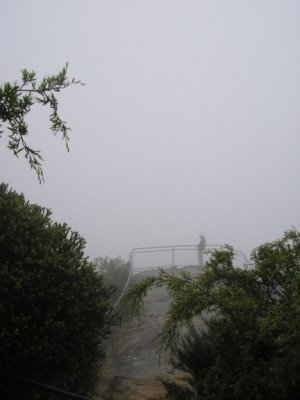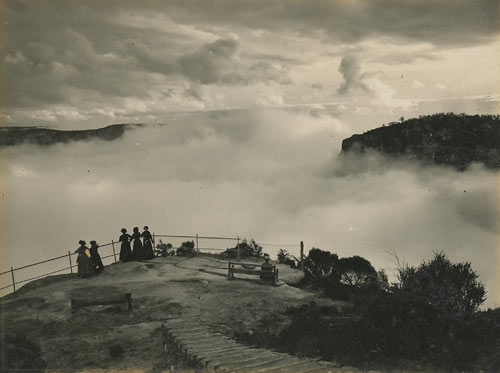
Rain, cloudy skies and mists are not uncommon features of life in the Blue Mountains of NSW. This photograph was taken last year by my daughter Petah at the Olympian Rock Lookout, Leura. Where usually there is a spectacular view of the Jamison Valley, the whole landscape was enveloped completely in a thick mist. It reminded me of something Delia Falconer wrote in her novel The Service of Clouds (Picador, 1997): “When the mists come …Your feet are shod in lichen. Your hair breathes vapour at the roots. You are walking on clouds.”
In past years the benefits of mountain mists were often promoted by the local tourist operators as countering the effects of our dry climate on female complexions. If only women realized, they argued, “how beneficial mountain mists are to the skin, we would see more young ladies taking advantage of a misty day for an outing … The mist or moisture of the atmosphere is necessary for the production of the blooming cheeks. What better then than a real heavy mist that sinks into the skin and softens it? Girls, you have the very thing right at your doors; why not take advantage of it?” (Blue Mountains Gazette, 5th June 1903)
Harry Phillips, perhaps the region’s finest photographer, took the photograph below about 1910 at Echo Point. He was a man passionate about clouds and mist. They became identifying characteristics of his work and many who knew him recalled how he would disappear with his camera for hours when a particularly strange or interesting formation occurred. On such days people would remark to each other, “I bet Harry’s happy!” Delia Falconer’s novel of the Blue Mountains, mentioned above, centres on the obsessions of a Phillips-like character and is full of mist and cloud. A sad, beautiful, remarkable book and highly recommended!

The mist, blanketing everything or shifting wraith-like, continually confuses and subverts our perspective. Some years ago having experienced a touch of misty disorientation – assisted by a screaming flock of Sulphur-crested Cockatoos – I wrote the following small poem and was pleased when it was published by the Tasmanian-based literary magazine Famous Reporter.
BLUE NEGATIVE
Sometimes
when mist settles on the Mountains
the cliffs appear suspended
and we, too, seem to float
above everything.
Birds drift across the sky,
a silent melody of black notes
until that taut skin of light vibrates
in a beat of white noise
and we’re sliding into the void
with the cockatoos
and it could be 1908, or maybe 1920,
just another present
caught in a camera’s lens,
a blue negative
discarded in the mist.
Misty days, when everything takes on a strange, veiled transparency, have long intrigued both locals and visitors alike. They are part of the mysterious mix of history and landscape that forms the character of the Blue Mountains. Living here you often find yourself “walking on clouds”.
© John Low
